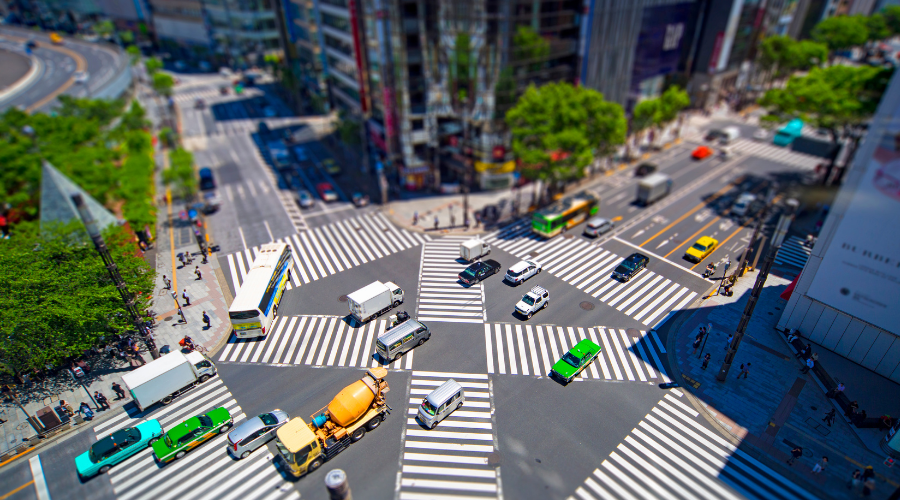Traffic Tracking & Analysis for Safer Cities

How to reduce pedestrian risk as urban populations increase
Experts at the World Health Organization report that as of 2015, 54% of the world’s population lived in cities, and that 60% of people worldwide will live in urban areas by 2050. Theoretically, that will lead to an increase in vehicles and pedestrians, which could increase the possibility of accidents between vehicles, and between vehicles and pedestrians. To make their streets and sidewalks safer for pedestrians, some cities are already deploying various Smart solutions, such as LED Smart Crossings in London, Smart Pedestrian Crossing Signals in Dubai, and Smart Street Lights in San Diego.
Another sensor that is taking on a more prominent role is the CCTV surveillance network: Smart Cities are increasingly equipped with surveillance networks, which are most often used to monitor for accidents or crime and facilitate post-incident investigations. However, some Smart Cities have realized that the video footage captured by those cameras contains valuable data that can help them do much more than just prevent incidents and solve crimes. The problem is that city agencies do not have enough manpower or time to manually review the high volume of footage that is collected by the cameras, nor can human observation accurately comprehend and analyze the millions of objects and interactions that are captured in video footage. To further drive efficiency, Smart Cities use complementary video analytics software that identifies, processes and indexes objects and behaviors found in video footage.
Powered by Deep Learning and Artificial Intelligence (AI), video content analytics software is able to identify and classify objects, such as vehicle types, from bicycles to motorcycles and trucks, as well as men, women, children, and animals. This enables video analytics operators to conduct sophisticated searches for objects, in real-time camera views as well as archived footage. Video intelligence software also aggregates data, which is useful not only to uncover the patterns and trends that are buried in surveillance data, but also to help operators define normal thresholds or benchmark conditions. Operators can then use those benchmarks to configure rule-based alerts that are triggered when those predefined thresholds are exceeded. This notifies operators so they can be attentive to situations as they are evolving, in real-time.
This combination of aggregated trend data and real-time alerts offers city planners and first responders a way to collect quantitative data and attain situational awareness. City agencies from urban planning to law enforcement already apply video intelligence in numerous ways, but this blog post will focus on how it helps those agencies improve pedestrian safety.
Identifying crowding and bottleneck hotspots
Obviously, pedestrian-vehicle accidents can result in serious injury or death. To better protect pedestrians, urban planners and law enforcement agencies need to identify both pedestrian and vehicle hotspots, and optimize the flow of traffic. Knowing where and when traffic congestion occurs is the key to helping law enforcement agencies mitigate collisions or congestion. To resolve immediate traffic congestion problems in real-time, some video content analysis solutions offer object and people-counting capabilities, to alert officers in real-time when an area becomes too crowded with people or congested with vehicles.
To help city planners discover ineffective traffic patterns, signage, or roadways, video analysis can be leveraged to provide quantitative data about bicycle, vehicle, and pedestrian traffic at particular intersections, sidewalks, bike paths, and roadways, across multiple locations and cameras. Planners can make better, more informed decisions about required roadways, signage and public transit for driving future efficiency.
However, it’s not sufficient to have only quantitative data about the volume of cars, bicyclists and pedestrians; a comprehensive video intelligence solution should render data in the form of heatmaps for indicating highly trafficked vehicle or pedestrian paths . Heatmaps are also helpful for benchmarking normal activity, so that the system alerting can be configured to detect when traffic violations occur, such as vehicles moving against the flow of traffic or making illegal turns.
Line-crossing alerts can prevent vehicle-pedestrian collisions
Some cities have pedestrian-only and no-pedestrian zones. To help enforce behavior in these zones, video analysis software may detect line-crossing: i.e., when cars cross into defined pedestrian-only areas of a road, or conversely a pedestrian crosses into a vehicles-only space such as a bridge, highway or tunnel. By sending a real-time alert to a surveillance operator, a video analysis system can trigger action from the appropriate forces, whether dispatching officers to the scene or more closely and actively monitoring an area through video surveillance.
Gathering Big Data to analyze vehicle and pedestrian traffic
With so many video cameras constantly recording video, there is a glut of Big Data. City agencies need video content analysis that can merge Big Data points and render them into meaningful data visualizations. For example, it’s good to know the quantity or types of vehicles that use a particular road, but it’s even better to know a variety of data points, such as the number of vehicles, the types of vehicles, and types of accidents on variety of particular roads. By presenting data in easy-to-understand, interactive dashboard reports, video analytics arms planners to make better decisions about traffic management and public safety, such as whether and where to install new crosswalks or traffic lights.
To optimize pedestrian safety, it is crucial for city agencies to be able to respond to problems in real-time and gather trend data about common traffic problems and violations so they can plan urban improvements based on actionable data. The easiest way to accomplish these goals is to leverage existing video surveillance infrastructure, by complementing that with video content analytics technology.
Signup to receive a monthly blog digest.